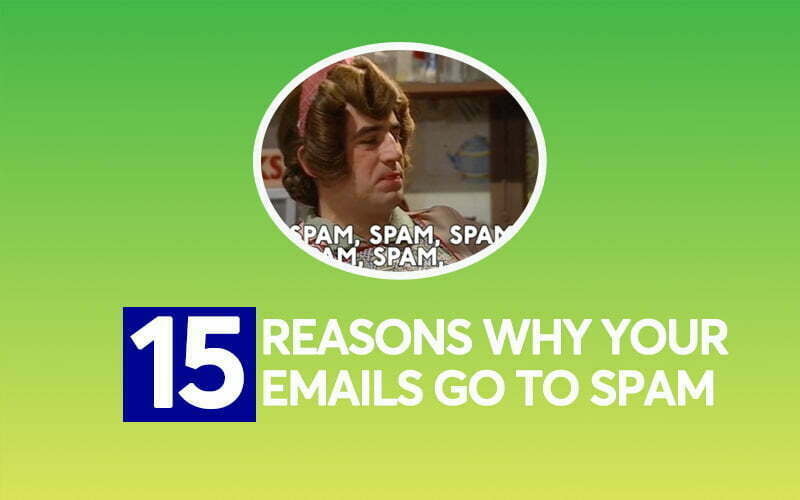Email marketing is one of the most effective marketing tools. In addition, it is available to literally every company and person. But what is the benefit of it if all emails end up in spam? In this article, I will explain to you why emails end up in spam and how to fix this problem.
Basic Information
To avoid spam, email services collect detailed information about senders. And the more emails they send, the more data is available for analysis. First of all, the response of recipients is taken into account. In other words, they check their complaints, as well as the presence of non-existent addresses among your recipients, and much more. All this information helps build a domain’s reputation.
Another caveat is that manually sending thousands of letters takes a very long time and is not always beneficial for the reputation of the domain. And there is a limit created by various mail services on sending letters for personal purposes. Therefore, for such tasks, special services are used that allow you to do this in one click. The advantage of mailing services is that there is no limit on them if you follow all the established rules.
But the downside is that many unscrupulous people can send letters with inappropriate content through the same services. Which, of course, can affect their reputation. As a rule, mailing services introduce an anti-spam policy to minimize such incidents and avoid spam. And there is a chance of getting into this policy if you do something wrong.
How to Understand That Your Emails Are in Spam
Spam folders are found in almost all popular email services. To find out if your emails get into them, you can do the following:
- Include one or more of your mailboxes into the list. After sending, you can easily check whether the letter fell under the filter or not. If at least one email has been spam-filtered, you need to immediately understand the reasons.
- If you use special services to send emails, just go to one of the sections with statistics. It will show you exactly how many emails were sent, went to spam, were read, and so on.
- You can also track statistics on domains in the email service report if such information, of course, is provided there. If the numbers have dropped, then there is a high probability of getting into the spam filter.
Analysis of Emailing
Almost every major email service has a tool for analyzing emailing, which is called a postmaster tool. It allows you to find out the email deliverability, the number of people who unsubscribed from the mailing list, if there were any problems with the delivery of the email, and other things that can help you to avoid spam filters.
To add a domain to statistics, you must first log in to the system of your email service. After that, you will need to enter the domain name in the field and click on the registration button. The action must be confirmed using an HTML file, meta tag, or DNS. If this operation is successful, you will have complete statistics on emailing.
Some services show statistics on individual messages. It will be relevant if a user sends several mailings on the same day and wants to know the effectiveness of each of them.
The Main Reasons Why Your Emails Go to Spam
There can be many reasons why emails end up in spam. To solve them, you first need to understand the essence of the problem.
Personal Spam Filters of Users
Any user can complain about your email or simply send it to the spam section. In the second case, it’s clear that your email will be in spam only for one user. But why does mass blocking start?
The rules of email services indicate the limits of complaints. For example, the number can be 1.4 percent if up to 10,000 letters are sent from your address per day. As the volume of mailings increases, this mark decreases. Overall, there will always be people who will complain about the letter because of the content. Fortunately, such people are few. But overall, a wrong cold email marketing may make your letters go to spam.
Low Domain Reputation
Any email service collects information about domains and makes a rating to avoid spam. This was discussed above. Some factors affect a domain’s reputation. They are the following:
- The presence of non-existent addresses and spam traps in the database, you have to verify the email adsresses with an Email Verifier Tool
- Email authentication.
- The statistics on the percentage of openings, reads, and clicks.
- The number of deleted messages before being read.
- The regularity of mailings.
- The presence of complaints from recipients.
- The use of programs and scripts when sending mailings.
- The nature of the content and links in the text.
- The number of replies and forwarding of emails.
Low Reputation of the Ip Address
This reason differs from the previous one in the fact that it occurs because of the actions of the sender, not the recipients. The thing is that email services use shared pools. This is a list of IP addresses from which emails are sent. If anyone starts sending spam from your IP, the reputation of all addresses in the pool will suffer.
A Mistake Made by the Email Service
This problem is less common, but it does occur, especially with private email services. Such a failure can randomly occur in spam filters, and not only your domain but also many others will suffer. Sometimes it can even happen with such large services as Google.
Problems with Layout, Text, and Letter Design
Different services that are used to send emails are based on special algorithms that calculate the techniques of spammers to avoid spam. Sometimes bona fide senders fall under them, and this is due to the peculiarity of email design and layout. This may be the wrong font color, a shortened link, the absence of alt tags in the images, etc. One detail may go unnoticed, but if there are several of them, the message will inevitably end up in spam. Therefore, if you experience difficulties with this, you may want to use email templates. The most common details that are worth your attention are the following:
- The presence of one picture in the email.
- The presence of prohibited elements such as JavaScript, Flash, or ActiveX.
- The use of bright fonts, lots of exclamation marks, or a set of phrases written with the turned on Caps Lock.
- The use of a link which is shortened using a special service or has a redirect to another site.
- The absence of a link to unsubscribe from the mailing.
- The presence of an incorrect encoding in the letter.
SPF Is Not Configured Correctly
SPF (Sender Policy Framework) is one of the many DNS records that store IP addresses. It is from them that it is allowed to send email newsletters from this or that domain. Thanks to this tactic, the mail service understands that it is you who are sending the letters, and not some intruder. Some do not require an SPF record, but just in case, it is better to specify it. And read a related article if you want to know more about “What is spf record?”
DKIM Is Not Configured Correctly
DKIM (Domain Keys Identified Mail) is a unique digital signature that distinguishes a fake email from a genuine one. It usually appears in the header of the letter. If you use special services for mailing, then DKIM is configured automatically. In other cases, you need to generate such a key yourself.
DMARC Is Not Configured
This is translated as Domain-based Message Authentication, Reporting, and Compliance. Simply put, it’s a way to protect your subscribers from phishing attacks and avoid spam using your domain. This helps prevent the leakage of usernames and passwords, payment card details, phone numbers, and so on.
It is this protocol that is responsible for checking SPF and DKIM records, as well as tracking the domain activity with the DMARC report analyzer. By default, the check is performed once a day, after which a report is received on the results of the check. If the check fails in any way, you will receive a special notification by email.
This tool is optional, but it may be the one that will help prevent emails from getting into spam.
Purchased Mailing Bases Are Used
If you used your mail to send hundreds of emails, and then bought a subscription to some service and began sending mailings to several thousand people, the email service will regard this as an unnatural action. In the future, all your emails will end up in spam, even though they are honest and conscientious.
How to Communicate with Support to Get Emails Out of Spam
If you got into a spam filter, corrected all the mistakes, waited some time, and the situation did not change, then you need to contact support. Before contacting, make sure you comply with the email service requirements.
After this, you need to ask the support team to adjust the filters to your mailings. Here’s how to do it in 4 steps.
Collect Data
First, you need to get files of emails that got into spam. If you do this, the support service will be able to quickly understand the situation and help you. You are not really interested in the text or HTML-template, but the whole email together with headers. The EML extension is used to send letters together with service headers.
And if the letter got into spam or was blocked on a corporate domain, you should also contact the administrators of this domain. Each server analyzes emails differently. Therefore, the reasons for getting into the spam can be found only from the side of an administrator.
Correctly Compose an Email that Will be Send to Support
In your first letter to your email provider, answer the following questions:
- What the company does. It is important to explain that you have a legitimate business. And if you are a blogger or freelancer without a legal entity, then just write what you do, what you send, as well as to what users you do this. In general, you need to explain that spam is not about you.
- How subscribers get into the database. Tell them about the sources of contacts, give a link to the subscription form and the site’s Privacy Policy. Check if you accept the correct consent to the newsletter and if you have configured a Double-Opt-In.
- What emails you are sending. If the email got into spam, attach a copy of it in EML format to the message. If the mail server blocked the message, add a sending log, which will be provided by the UniSender Customer Care Service.
It will be an advantage if you have postmasters configured. You can send a screenshot from the postmaster, which will confirm that your emails got into spam. In addition, you will be able to see yourself whether this is just one case, or the whole emailing went to spam.
Send a Request to the Correct Address
The method of sending a message to the support service differs from service to service. In cases of big providers, no difficulties should arise. But many smaller email providers do not have support services. It’s hard to get an answer from them. In this case, carefully read the help section on the email provider’s website. Perhaps it indicates exactly where to send your request.
Hope and Wait
From leading email services, the answer comes within one or two days. Support will either answer you that everything has been fixed or indicate why your emails are blocked, as well as offer to take some action. Most often, the situation is resolved within a few days or one-week maximum. If during this time you have not received any response, you can send your request again or inquire in the letter why there is no response.
Conclusion
Email marketing is truly one of the most effective tools. But to make it work, it is necessary to make great efforts, monitor the reaction of recipients, and follow the established rules.
If more than 1 percent of your emails end up in spam, this is a red flag. Create yourself a checklist, with the help of which you will check new emails for all the nuances. Analyze your audience thoroughly with reports. If there are users who do not read your emails, invite them to unsubscribe. There is no limit to perfection, you can always improve something.







 BONUS:
BONUS: The Challenge: Join this free course and I guarantee that after 5 days you will have the necessary skills to start generating B2B clients Growth Hacking and Prospecting techniques.
The Challenge: Join this free course and I guarantee that after 5 days you will have the necessary skills to start generating B2B clients Growth Hacking and Prospecting techniques.